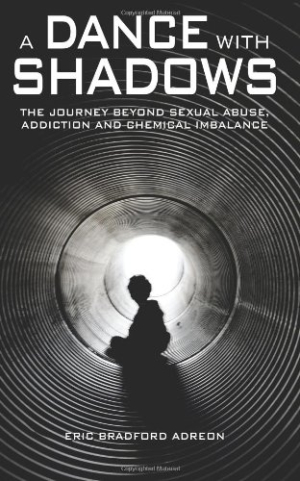A Dance With Shadows
The Journey Beyond Sexual Abuse, Addiction and Chemical Imbalance
What drives someone to develop a crushing drug habit by the age of thirteen? Modern psychology recognizes many coexisting causes, such as early trauma, genetic predisposition, and peer pressure. While allowing for all of these, self-described addict Eric Bradford Adreon suggests we should also look at the impact of undiagnosed mental illness caused by a chemical imbalance. In his reflective memoir, A Dance With Shadows: The Journey Beyond Sexual Abuse, Addiction and Chemical Imbalance, Adreon chronicles his journey through the many treatment programs that were unable to effect a cure until the underlying cause of his downward spiral was uncovered and understood.
“I traded a number two pencil for a syringe,” writes Adreon in his compelling opening that graphically illustrates the Seattle street scene he joined after dropping out of school. He draws readers in with images of heroin injections and dumpster diving. Adreon doesn’t dwell exclusively on these scenes, however, and thus avoids reducing his story to a confession to be read by voyeurs. Instead, he looks back at his experiences with an analytic eye, trying to sort out exactly how he went from school to prison in a few short years.
Adreon draws a clear picture of a childhood upended by sexual abuse and alcoholism and followed by a rapid escalation of drug use in his early teens. Scenes from a dark, soulless meth house open an especially graphic window into the frightening subculture that so quickly consumed him. Adreon’s criminal activity increased in parallel; by the age of twenty-one, he had cycled through treatment centers, wilderness therapy, halfway houses, missions, jails, and prisons. Although writing from a first-person perspective, Adreon occasionally seems emotionally detached when describing the most personal events, like his suicide attempts. The details are there, but he has a tendency to retreat into passive voice, distancing himself and the reader from the drama.
What Adreon does exceedingly well is illustrate his frustrating spiral of addiction and recovery. Each time he leaves a treatment center, he seems fully recovered, but then the cycle starts again. Readers will experience the same heartbreak suffered by families of addicts who stand by, astonished and grieved, as their loved one sinks to the bottom once more.
A genuine turning point for Adreon doesn’t come until late in the 500-plus pages of A Dance With Shadows. Making the appropriate diagnoses of Adreon’s mental illnesses—bipolar disorder, post-traumatic stress disorder, depression, and anxiety—allows doctors to prescribe safe treatments to replace the risky, illegal self-medication that Adreon had been attempting for years.
Adreon deems this new treatment a true success. Indeed, it has allowed him to complete this ambitious memoir, which succeeds as both a therapeutic journey for the author and a beacon of hope for readers going through similar struggles.
Reviewed by
Sheila M. Trask
Disclosure: This article is not an endorsement, but a review. The publisher of this book provided free copies of the book and paid a small fee to have their book reviewed by a professional reviewer. Foreword Reviews and Clarion Reviews make no guarantee that the publisher will receive a positive review. Foreword Magazine, Inc. is disclosing this in accordance with the Federal Trade Commission’s 16 CFR, Part 255.

